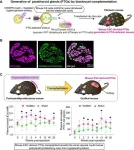(Press-News.org) A busy, crowded, confusing emergency room is not an ideal place for a person living with dementia.
But 1.4 million times a year, people with Alzheimer’s disease and other forms of dementia end up in emergency care, a new study shows.
Together, they make up nearly 7% of all emergency visits for any reason by people over age 65, according to a University of Michigan team’s findings published in JAMA Neurology.
And compared with their peers who don’t have dementia, these patients have twice the rate of seeking emergency care after an accident or a behavioral or mental health crisis, the researchers show.
With about 6 million Americans currently estimated to have dementia, the study suggests there’s a lot of opportunity to prevent future emergency visits by better supporting dementia caregivers, thereby, the researchers say.
Lead author Lauren B. Gerlach, D.O., M.Sc., says the findings could help inform efforts to support family caregivers and nursing facility staff in reducing patients’ risks of injury, and preventing the agitation, aggression and distressing behaviors that people with dementia can experience.
“While dementia is thought of as a cognitive or memory disorder, it is the behavioral aspects of the disease such as anxiety, agitation and sleep disturbances that can cause the most stress for caregivers and patients alike”, said Gerlach, a geriatric psychiatrist at Michigan Medicine, U-M’s academic medical center. “Emergency departments are often not the right place to manage these behaviors,” she added. “We really need to do better to support caregivers so there are options other than seeking emergency care.”
Once a person with dementia is in the emergency department, it can be a very disorienting experience, Gerlach explains. “This is especially true in the context of a busy ED where visits can last many hours and patients may have difficulty understanding what is occurring or communicating their needs,” she said. “Even routine blood draws from unfamiliar staff can be a very scary experience for a patient with advanced dementia.”
To make matters worse, behavioral symptoms common in this group can lead to treatment with potentially dangerous sedative medications.
Emergency department patients with dementia received antipsychotic medications at more than twice the rate as other emergency patients over age 65 during their visit, the study shows. Such drugs, often used to sedate people with dementia and calm their behavioral symptoms, can carry major risks if used long-term – including increasing the risk of fall accidents and death as highlighted in warnings from the U.S. Food & Drug Administration. Long after the emergency has ended, the concern is that these newly started antipsychotic and sedative medications in could then continue to be prescribed long-term, putting patients with dementia at further risk, said Gerlach.
The study also adds evidence that older adults with dementia may be treated differently in the emergency department. People with dementia were much more likely than those without to receive a urine test or a CT scan of their head.
“Difficulty in the ability of patients with dementia to communicate their symptoms verbally can make it challenging to distinguish what is causing their symptoms,” Gerlach explains. “Is it related to a change in their environment, difficulty between the patient and their caregiver, or an underlying medical issue?”
For instance, urinary tract infections can cause pain that can lead to agitation or aggression in a person with dementia, who may not be able to express what they’re feeling. However, these challenges can sometimes lead to indiscriminate laboratory testing and imaging, Gerlach adds.
The data for the study came from the National Hospital Ambulatory Medical Care Survey conducted by the Centers for Disease Control and Prevention, and include information on people over 65 no matter what form of health care coverage they had.
Gerlach and Matthew A. Davis, Ph.D., an associate professor in the U-M School of Nursing and Michigan Medicine’s Department of Learning Health Sciences, note that there has not been much research on emergency care for people with dementia, despite the fact that clinicians and caregivers who care for such patients know from experience that emergencies can be common.
Helping caregivers prevent and respond to dementia-related crises
Caregiver stress and burnout from a lack of respite or support may play a role in the need for seeking emergency care in people with dementia, noted Gerlach, who is an assistant professor in the U-M Department of Psychiatry.
She sees promise in a new proposed Medicare rule that would allow health care teams to get reimbursed for sessions that educate family caregivers – including on how to prevent or soothe behavioral symptoms among their loved ones.
One approach to this, called DICE, was co-developed at Michigan Medicine’s geriatric psychiatry division and is now available online to dementia caregivers anywhere. Gerlach also recommends the caregiver support programs and information offered by the Alzheimer’s Association, and videos from UCLA Health, available in multiple languages, to her patients’ caregivers to help manage these behaviors.
Those who live with people who have dementia should also consider safety upgrades in the home to reduce fall risks and the chance of other injuries. “It’s important to match the home environment to their needs and ability, which could reduce the risk of emergency care being needed,” Gerlach said.
The rise of geriatric-focused emergency departments or areas within larger emergency departments may also help, Gerlach noted, but they are not available in all areas.
It’s also important for families to be realistic about when it’s time to seek emergency services for their loved one with dementia.
If physical aggression or falling risk gets to be too much for a family caregiver to handle, the safety of the patient and the caregiver must outweigh the desire to keep them at home, Gerlach says. “But before that, there is a lot we can do in the outpatient setting to help prevent crisis and the need for emergency care,” she said.
The study was funded by the National institute on Aging, part of the National Institutes of Health (AG066864, AG066582) including the grant that funds the U-M Center to Accelerate Population Research in Alzheimer’s, headed by co-author and geriatrician Julie Bynum, M.D., M.P.H.
Gerlach, Davis and Bynum are members of the U-M Institute for Healthcare Policy and Innovation. U-M data analyst Jonathan Martindale, MHI, is also an author on the paper.
Citation: Characteristics of Emergency Department Visits Among Older Adults With Dementia, JAMA Neurology, DOI:10.1001/jamaneurol.2023.2244
END
Dementia becomes an emergency 1.4 million times a year
Accidents and behavioral disturbances lead the list of reasons for emergency department visits – suggesting need for better caregiver support to prevent crises
2023-07-24
ELSE PRESS RELEASES FROM THIS DATE:
Study: Inflation Reduction Act’s cap on insulin out-of-pocket costs boosts prescription fills
2023-07-24
LOS ANGELES – The Inflation Reduction Act’s policy capping out-of-pocket costs for insulin to $35 for a month’s supply led to increases in the total number of insulin fills for Medicare beneficiaries, according to a new study from the USC Schaeffer Center for Health Policy & Economics and University of Wisconsin–Madison.
Following the cap’s enactment in January 2023, the number of insulin fills among Medicare Part D enrollees increased from 519,588 to 523,564 per month. In contrast, the number of insulin fills decreased among older adults without Medicare during the same period. The study was published today in the Journal of ...
FASEB joins Society Publishers to recommend diversity initiatives for publications
2023-07-24
ROCKVILLE, Md. — The Federation of American Society for Experimental Biology (FASEB) recently co-authored a report to provide guidance to society publishers on how to address diversity and inclusivity matters within their journal programs. Titled Recommendations for Equity, Diversity, and Inclusion Initiatives for Society Publishers, the report was published by the Society Publishers’ Coalition, of which FASEB is a member. Darla P. Henderson, PhD, FASEB Director of Open Science and Research Integrity and Director of Publications, represented FASEB and was among the report’s ...
Successful generation of functional parathyroid glands from mouse embryonic stem cells
2023-07-24
Researchers from Tokyo Medical and Dental University (TMDU) show that it is possible to generate functional parathyroid glands using mouse embryonic stem cells using blastocyst complementation
Tokyo, Japan – Regenerative medicine has opened up exciting possibilities in the world of medicine. Now, researchers in Japan are searching for ways to recreate and rebuild body tissues and organs, which may be an alternative cure for diseases.
In a recently published study in Proceedings of the National Academy of Sciences (PNAS), researchers from Tokyo Medical ...
BGI Genomics Global Cervical Cancer Insights - Young women have higher vaccination rates but put off by pap smears
2023-07-24
To further motivate action to combat cervical cancer, BGI Genomics today released its State of Cervical Cancer Awareness Report. This report is released on World Self-Care Day, July 24, 2023, as the WHO notes that self-care - including cervical cancer screening - can be practiced "24 hours a day/7 days a week".
This report assesses the level of knowledge, attitudes, and practices related to cervical cancer screening and the human papillomavirus (HPV) vaccine. By examining these key areas, ...
Cancer among people experiencing homelessness: research into current situation forms basis for prevention program
2023-07-24
(Vienna, 24 July 2023) Cancer is twice as likely to affect people experiencing homelessness (PEH) as members of the housed population. The disease is the second most common cause of death among PEH, a group that is underserved when it comes to medical care. At the same time, there is a lack of awareness and of structures for targeted cancer screening. Against this backdrop, a team headed by MedUni Vienna has examined the current situation in four European countries and drawn up approaches for the development of a prevention programme. ...
PKU researchers make major progress in convective turbulence
2023-07-24
Researchers from the Department of Mechanics and Engineering Science at Peking University (PKU), led by Prof. Chen Shiyi and Prof. Yang Yantao, have recently proposed a groundbreaking mechanism to enhance the efficiency of heat transfer in convective turbulence. The paper has been published in the first-class journal Physical Review Letters, entitled “Boundary-Layer Disruption and Heat-Transfer Enhancement in Convection Turbulence by Oscillating Deformations of Boundary.”
Convective turbulence, driven by gravity-induced instabilities resulting from temperature ...
How toxic is alcohol? This PKU-Oxford team seeks answers
2023-07-24
Recently, a study conducted by researchers from Peking University and Oxford Population Health shed light on the susceptibility of Chinese men to 60 diseases related to alcohol consumption. The study, titled "Alcohol consumption and risks of more than 200 diseases in Chinese men," was published in the prestigious journal Nature Medicine.
Alcohol consumption poses a significant global health threat, with previous research highlighting its strong association with diseases such as liver cirrhosis, stroke, and various types of cancer. However, there has been a lack of ...
Discovery of pair density wave state in a two-dimensional high-Tc iron-based superconductor
2023-07-24
As a macroscopic quantum state of matter, superconductivity has attracted tremendous attention in the field of scientific research and industry over the past century. According to the BCS (Bardeen-Cooper-Schrieffer) microscopic theory, superconductivity arises from the condensation of coherent Cooper pairs, and each Cooper pair is formed by two electrons with opposite spins and momenta. Theoretically, when time-reversal symmetry is broken, Cooper pairs may acquire a finite momentum and exhibit a spatially modulated superconducting order parameter, which is known as the Fulde-Ferrell-Larkin-Ovchinnikov ...
PKUers finds key evidence for existence of nanohertz gravitational waves
2023-07-24
A group of Chinese scientists has recently found key evidence for the existence of nanohertz gravitational waves, marking a new era in nanohertz gravitational wave research. The research was based on pulsar timing observations carried out with the Five-hundred-meter Aperture Spherical Telescope (FAST).
The research was conducted by the Chinese Pulsar Timing Array (CPTA) collaboration. Researchers (Prof. Kejia Lee, Post-Doc. Siyuan Chen, PhD students Jiangwei Xu, and Zihan Xue) from Department of Astronomy ...
MSU study links cadmium levels in women’s urine to endometriosis
2023-07-24
EAST LANSING, Mich. – Women with a history of endometriosis had higher concentrations of cadmium in their urine compared to those without that diagnosis, according to a Michigan State University study that suggests the toxic metal could be linked to the development of endometriosis.
Affecting one in 10 reproductive-age women, endometriosis is a gynecologic condition in which tissue that looks like the lining of the uterus, or womb, appears outside the uterus. Those with endometriosis can experience chronic, painful and debilitating symptoms, which can interfere with all aspects of life, including daily activity, work productivity, ...
LAST 30 PRESS RELEASES:
The perfect plastic? Plant-based, fully saltwater degradable, zero microplastics
Bias in data may be blocking AI’s potential to combat antibiotic resistance
Article-level metrics would provide more recognition to most researchers than journal-level metrics
Satiety’s little helper: Protein that supports appetite regulating protein identified
UF dives deep into predicting storm damage with computer models
A stormy ocean voyage yields insights on the global carbon cycle
Scientists identify first non-coding gene that controls cell size
Demonstration of altermagnetism in RuO₂ thin films -- A new magnetic material for the AI era
Penn researchers awarded $25M to conduct trial using smartphones to fight heart disease
PCORI awards funding for new patient-centered healthcare research
Exploring the origins of the universe: 145 low-noise amplifiers complete ALMA telescopes
Empress cicada wings help illuminate molecular structure
Using sound waves to detect helium
Time burden in patients with metastatic breast and ovarian cancer from clinic and home demands
Researchers discover bias in AI models that analyze pathology samples
Scientists ID potential way to prevent brain injuries from triggering Alzheimer's
MASTER 2nd Open Call: Execution period kick-off
Algae for health in food and pharma
Advanced microrobots driven by acoustic and magnetic fields for biomedical applications
Chicago health information leader recognized for raising CPR readiness and blood pressure awareness
The Intimate Animal, a new book from Kinsey Institute Executive Director Dr. Justin Garcia
When blue-collar workers lose union protection, they try self-employment
New video dataset to advance AI for health care
MEA-based graph deviation network for early autism syndrome signatures in human forebrain organoids
New modeling approach sheds light on rare gut disease
Study documents potentially hazardous flame retardants in firefighter gear
Can certain bacteria regulate aging of the immune system and its related alterations?
AI model helps diagnose often undetected heart disease from simple EKG
There are fewer online trolls than people think
Cell membrane fluctuations produce electricity
[Press-News.org] Dementia becomes an emergency 1.4 million times a yearAccidents and behavioral disturbances lead the list of reasons for emergency department visits – suggesting need for better caregiver support to prevent crises


